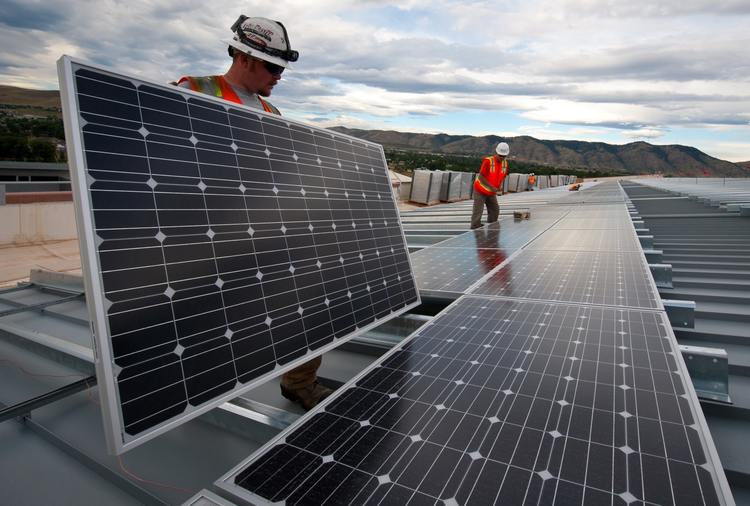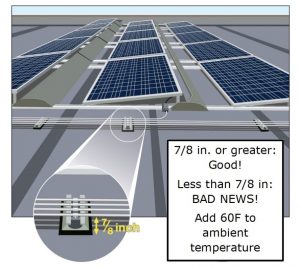Conductor Derating on a Rooftop Made Easy

By: Robert Robinson | Mar 31, 2020
Derating conductors for the environment where they are installed is an important consideration for selecting the type and size of conductor for a particular installation. When installing a system on a rooftop, special consideration must be given to the ambient temperature inside the wire way or conduit that contain the conductors to prevent heating beyond the rating of the insulation of the conductors.
Conductors installed in raceways on rooftops can be subject to higher temperatures than they would be just from the heating effect of solar energy absorbed by the wall of the raceway. This effect becomes more evident when the proximity is very close to the roof or the raceway is in contact with the roof surface.
The 2014 NEC Table 310.15(B)(3)(c) required the addition of various temperature “adders” to the ambient temperature that changed with the distance from the roof surface. A temperature adder of 60 degree F was required for a raceway less than ½”, 40 degree F where over ½” but less than 3 ½”, 30 degree F where over 3 ½” but less than 12” and 25 degree F when over 12” and less than 3’. Even the addition of 25 degrees can result in a derating factor of 0.50 if using the 60 degree C column. Building a rack on the roof over 3 feet high is not practical so a substantial increase in wire size is almost always necessary per the 2014 NEC.
A special task group was created to analyze the temperature increase on rooftops. A study was done by the University of Nevada, Las Vegas (UNLV) in conjunction with International Association of Electrical Inspectors (IAEI) and Institute of Electrical and Electronics Engineers (IEEE) and it was determined that the temperature adders in Table 310.15(B)(3)(c) were not necessary – the table has been deleted from the 2017 NEC. The elimination of this table is a good thing that simplifies design, installation, and inspections of rooftop systems.
The 2017 NEC does still address the need to modify ampacities for ambient temperature in the region and has retained the 60 degree F adder for installations within 7/8” of a rooftop. The adder should be enough to prevent almost all designs from being within the 7/8” distance.
310.15(B)(3)(c) in the 2017 NEC states:
“Where raceways or cables are exposed to direct sunlight on or above rooftops, raceways or cables shall be installed a minimum distance above the roof to the bottom of the raceway or cable of 7⁄8 of an inch. Where the distance above the roof to the bottom of the raceway or cable is less than 7⁄8 of an inch, a temperature adder of 33°C or 60°F shall be added to the outdoor temperature to determine the applicable ambient temperature for application of the temperature correction factors in Table 310.15(B)(2)(a) or Table 310.15(B)(2)(b).”

A discussion about temperature ratings will always need to include 110.14 of the NEC. A careful look at 110.14(C)(1) indicates that a circuit 100 amps or less must use the 60 degree C column when derating the conductor regardless of the conductor’s rating. A higher temperature-rated conductor may be used to provide a higher current rating for a given size, but it may not be installed within 7/8” of a rooftop that has an adjusted temperature over 131 degree F. An environment that has an ambient temperature rating over 71 degree F may not have any circuits 100 A or less below 7/8” due to the 60 degree adder from 310.15(B)(3)(c).
The simple rule here is: never install a circuit 100A or less directly on a rooftop unless you live in a very cold climate.



IF a rooftop raceway or conductor is generally above 7/8″ above roof and then drops down below 7/8″ for a short distance , is there a length threshold where the adder applies. Is a 2 foot drop below 7/8″ tolerated on an otherwise 7/8″ installation? (6″ or 1′) or does every inch across the entire length need to be above 7/8″?
I’m not an expert on the matter, but would reason that if those 2 feet of raceway, with conductors inside, were left less than the required 7/8″ height, it would (without a doubt) cause damage to that length of conductors’ insulation, and ultimately make that circuit fail sooner rather than later. I would say it will have to be maintained throughout the entirety of the raceway run above the roof.